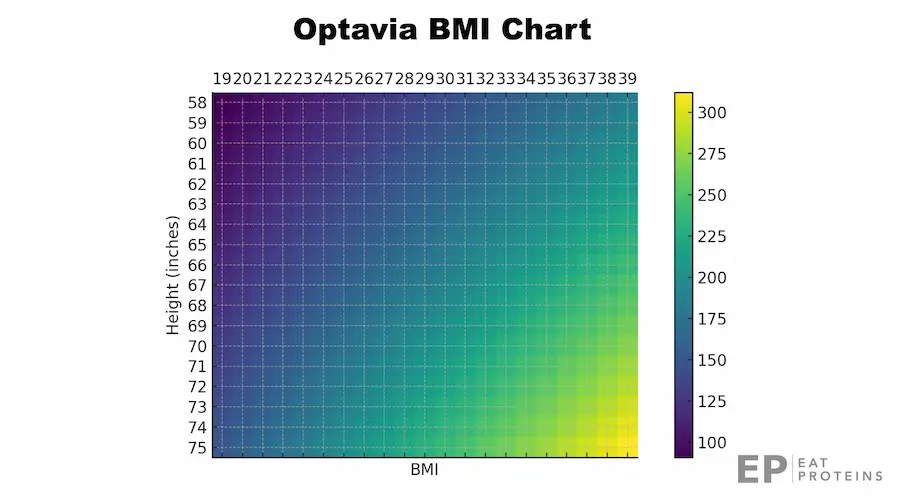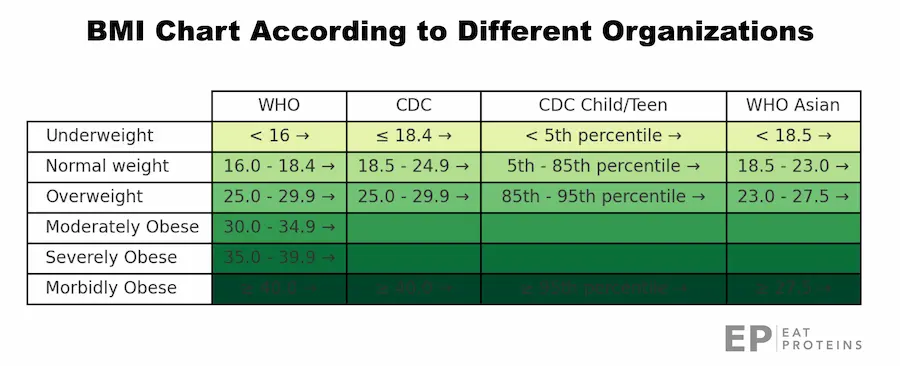
The Optavia BMI chart is a metric used to define anthropometric height/weight characteristics in adults and categorize them into groups. It is commonly interpreted as an index of an individual’s fatness. The 2015 study by Frank Q Nuttall from the University of Minnesota supported the use of BMI for classifying individuals and assessing health risks.
However, the study also acknowledges that BMI is a poor indicator of your percent body fat and doesn’t provide information about fat distribution in different body sites, which can be relevant for your health and social issues.
The Optavia BMI Calculator is a tool designed to estimate your BMI based on your height and weight measurements. Its primary purpose is to quickly assess your body mass index, which is commonly used as a risk factor for various health conditions. The Optavia BMI calculator aims to help you track your progress and make informed decisions regarding your weight management goals.
What Is Optavia BMI Chart?
The Optavia BMI chart is a tool that helps you assess your body mass index (BMI). BMI is a measure of health and fitness endorsed by the Surgeon General of the United States. It takes into consideration your height and weight to provide you with an accurate index of what your weight should be.
According to the Optavia BMI chart, a BMI of up to 25 is considered healthy. If your BMI falls between 25 and 29, it means you are overweight. A reading between 30 and 39 indicates obesity, putting you at a higher risk of developing heart disease, high blood pressure, diabetes, and other ailments.
If your BMI is 40 or higher, it indicates extreme obesity, placing you at the highest risk of health problems. This graph shows the Optavia BMI chart.

What Is Optavia BMI Calculator?
The Optavia BMI Calculator is a tool that helps you calculate your Body Mass Index (BMI). It utilizes a formula based on your weight and height measurements. The specific formula varies depending on whether you use metric or imperial (US) units.
If you’re using metric units, you divide your weight in kilograms by your height in meters squared to determine your BMI (BMI = kg/m^2).
If you prefer imperial units, you divide your weight in pounds by your height in inches squared and then multiply the result by 703 (BMI = 703 * (lbs/in^2)).
Below you can see the Optavia BMI calculator.
Optavia BMI Calculator
Please enter your height and weight:
How Important Is BMI On Optavia Diet?
To understand the significance of BMI and its implications on the Optavia diet and your health, it’s important to be aware of the established cut-off points set by organizations such as the World Health Organization (WHO) and the Centers for Disease Control and Prevention (CDC). These cut-off points categorize individuals based on their BMI, as shown in this graph.

The World Health Organization (WHO) defines the following BMI categories:
- Severely Underweight: BMI less than 16 kg/m^2
- Underweight: BMI between 16.0 and 18.4 kg/m^2
- Normal weight: BMI between 18.5 and 24.9 kg/m^2
- Overweight: BMI between 25.0 and 29.9 kg/m^2
- Moderately Obese: BMI between 30.0 and 34.9 kg/m^2
- Severely Obese: BMI between 35.0 and 39.9 kg/m^2
- Morbidly Obese: BMI greater than or equal to 40.0 kg/m^2
The Centers for Disease Control and Prevention (CDC) also provides BMI categories:
- Underweight: BMI less than or equal to 18.4 kg/m^2
- Normal weight: BMI between 18.5 and 24.9 kg/m^2
- Overweight: BMI between 25.0 and 39.9 kg/m^2
- Obese: BMI greater than or equal to 40.0 kg/m^2
For children and teenagers aged 2-20, the CDC has specific BMI categories:
- Underweight: BMI below the 5th percentile
- Healthy weight: BMI between the 5th and 85th percentile
- Overweight: BMI between the 85th and 95th percentile
- Obese: BMI greater than or equal to the 95th percentile
The World Health Organization (WHO) has specific BMI criteria for the Asian population:
- Underweight: BMI less than 18.5 kg/m^2
- Normal weight: BMI between 18.5 and 23.0 kg/m^2
- Overweight: BMI between 23.0 and 27.5 kg/m^2
- Obese: BMI greater than or equal to 27.5 kg/m^2
By utilizing the Optavia BMI chart and calculator, you can calculate your BMI and determine which category you fall into based on these recognized standards. This tool provides valuable insights into your weight status and potential health risks.
What Are The Pros of The Optavia BMI Chart?
Here are the pros of using the Optavia BMI Chart and Optavia BMI Calculator as tools.
- The Optavia BMI Chart provides a standardized and widely accepted method for categorizing individuals based on their body mass index.
- It can be useful for population-based studies and public health policies by defining specific categories of body mass as a health concern.
- The Optavia BMI Calculator offers a quick and convenient way to calculate an individual’s BMI based on height and weight measurements.
- It can help individuals track their progress and monitor changes in their body mass index over time.
What Are The Cons of The Optavia BMI Chart?
The drawbacks of using the Optavia BMI Chart and calculator and listed below.
- Optavia BMI Chart is considered a poor indicator of percent body fat. It doesn’t take into account the actual percentage of fat in your body, and it also fails to consider the distribution of fat in different areas of your body.
- Optavia BMI Chart is that there is a wide range of BMI values within which the mortality risk is relatively modest. This means that the relationship between BMI and health outcomes can vary depending on your age and other individual factors.
- Just like the Optavia BMI Chart, the Optavia BMI Calculator doesn’t provide specific information about your body fat percentage or the distribution of fat in your body. It focuses solely on calculating your BMI based on your height and weight measurements.
- BMI is a general screening tool and should be interpreted with caution. It doesn’t take into account important factors such as muscle mass, bone density, and overall body composition. These factors can significantly influence your health and well-being, but they are not reflected in the BMI calculation alone.
What Other Calculators Optavia Use?
Optavia utilizes other calculators in addition to the Optavia TEE (Total Energy Expenditure) calculator. The Optavia TEE calculator is particularly important as it helps establish your calorie intake during the transition and maintenance phases of the Optavia program.
The Optavia TEE calculator is designed to estimate your total energy expenditure, which refers to the number of calories your body needs to maintain its current weight.
By inputting relevant information such as your age, gender, weight, height, and activity level, the Optavia TEE calculator calculates an estimate of your daily calorie needs.
